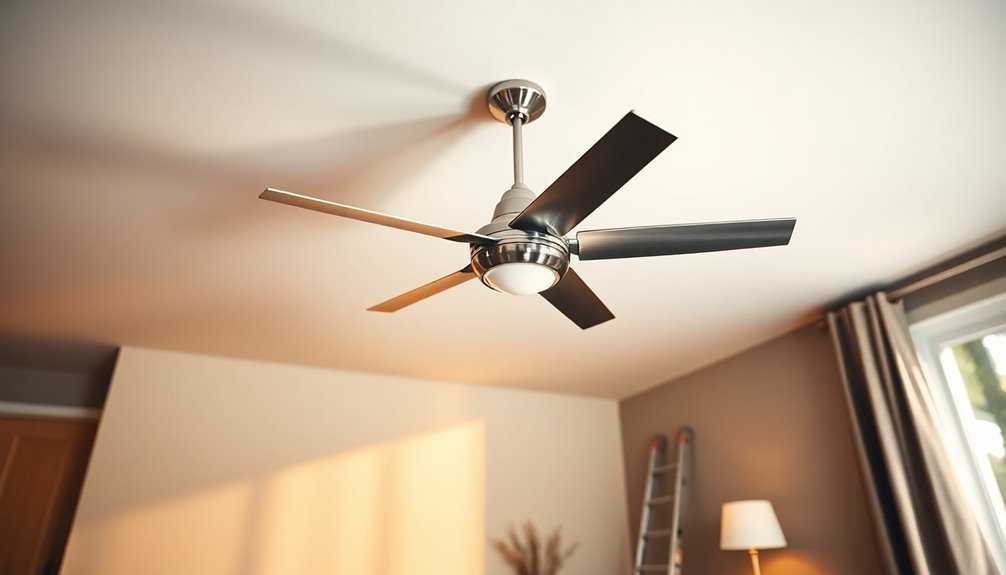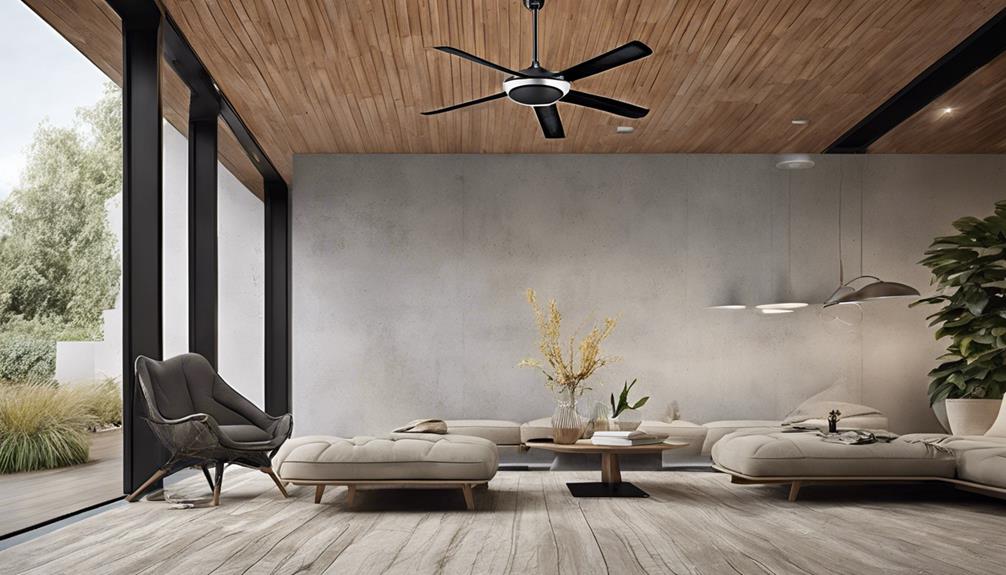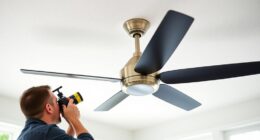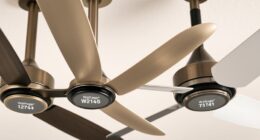Installing a ceiling fan with existing wiring generally costs between $100 and $500. Factors like the complexity of the installation, the fan type, and your ceiling height can influence the total price. Labor costs usually run from $50 to $200 per hour, with most jobs taking about 1 to 2.5 hours. If you choose a basic fan, expect to pay around $50 to $300 for it. Don't forget additional costs for accessories and features, as they can add up. If you stick around, you'll discover tips to optimize your installation experience and budget effectively.
Key Takeaways
- Installation costs for a ceiling fan with existing wiring typically range from $100 to $500, averaging around $249 based on local labor rates.
- Labor costs usually fall between $50 to $200 per hour, with straightforward installations generally totaling $100 to $300.
- Standard fans cost between $50 and $300, while specialized fans can range from $200 to $900 or more, depending on features.
- Additional features like remote controls or integrated lights can add $30 to $300 to the overall installation cost.
- Factors such as ceiling height, existing wiring condition, and added features can significantly influence the final installation price.
Overview of Installation Costs

When evaluating the installation of a ceiling fan, you'll typically find that costs can range greatly. For homeowners looking to install a ceiling fan with existing wiring, the average installation cost falls between $100 and $500. This range depends on the complexity of the installation and the type of fan you choose.
Labor costs are an important factor to assess; they usually range from $50 to $200 per hour, with most installations taking about 1 to 2.5 hours.
On average, you can expect total installation costs—including the fan unit and labor—to be around $249. However, this can vary based on local labor rates. If you're contemplating adding features like remote controls or integrated lighting, be aware that these can increase your total costs by an additional $30 to $100.
Fortunately, if you keep the installation simple by utilizing existing wiring, you can save considerably on installation costs, as you won't need new wiring or electrical boxes. This approach is often the most affordable option for many homeowners looking to enhance their living spaces.
Breakdown of Fan Prices

When you're shopping for a ceiling fan, it's crucial to understand the price range you'll encounter.
Fans can vary considerably in cost based on their features and design, so knowing what to expect helps you make an informed choice.
Let's break down the pricing for standard, low-profile, and specialty fans to see what fits your budget and needs.
Price Range Overview
How much should you expect to spend on a ceiling fan installation? The ceiling fan installation cost varies, especially with existing wiring and the type of fan you choose. Here's a breakdown to help you budget effectively:
| Type of Fan | Price Range | Professional Installation Costs |
|---|---|---|
| Standard Ceiling Fans | $50 – $300 | $60 – $250/hour |
| Specialized Fans | $150 – $550 | Varies based on complexity |
| Additional Features | +$30 – $100 | |
| Installation Accessories | +$10 – $75 |
Fan Features Impact Cost
The price of a ceiling fan installation isn't just about the fan itself; the features you choose can considerably impact the overall cost.
Standard ceiling fan costs typically range from $50 to $300, while low-profile fans for lower ceilings fall within this range too. If you have high ceilings, hanging propeller fans are ideal, costing between $150 and $550.
For added functionality, you might consider directional fans, which allow adjustable airflow and range from $150 to $800, depending on your room's needs.
If you're looking for something more advanced, rotational fans designed for larger spaces can set you back between $200 and $1,500.
On the higher end of the spectrum, premium smart ceiling fans, which offer app connectivity and advanced features, range from $120 to $400, with some exceeding $1,000.
Keep in mind that the cost of installing these fans also includes hiring an electrician to install them, as well as installation labor fees.
Specialty Fans Pricing Guide
Finding the right specialty ceiling fan can be a game-changer for your space, and understanding the pricing is crucial. Specialty fans cater to specific needs and can vary greatly in price.
For instance, low-profile models, perfect for rooms with ceilings under 8 feet, typically range from $200 to $650. If you have higher ceilings, hanging propeller fans are designed for rooms over 9 feet and cost between $300 and $900.
Directional fans, which allow you to adjust air flow, start at around $300, while rotational fans with dual motors can cost anywhere from $350 to $1,850.
If you're considering outdoor ceiling fans, keep in mind they're built to endure the elements and range from $250 to $3,000, depending on features and durability.
When you plan to install a ceiling fan, don't forget to factor in installation costs, which include labor costs.
This pricing guide helps you make an informed decision and guarantees your specialty fan choice enhances your space while fitting your budget.
Accessories and Additional Costs

When installing a ceiling fan, you should consider various accessories and additional costs that can impact your overall budget.
If you're using existing wiring, you might want to add remote controls or wall switches, which typically range from $30 to $100. Extension downrods are essential for adjusting your fan's height; these can cost anywhere from $10 to $75, depending on how long you need them. Upgrading to energy-efficient appliances can also lead to increased comfort and reduced electricity costs. Additionally, choosing a fan with a higher Seasonal Energy Efficiency Ratio (SEER) can result in better energy management, contributing to improved air quality in your space. High-end fans often feature advanced technology integration, which can enhance user experience.
If your ceiling is sloped, a sloped ceiling adapter is necessary for proper installation, usually costing around $37. Additionally, if your fan doesn't include them, optional remote receivers can add about $30 to your total.
To enhance air quality and aesthetics, you might also consider blade covers, which can set you back another $20 to $35. Moreover, investing in energy-efficient technology can lead to additional long-term savings on your energy bills.
All these accessories and additional costs can add up quickly, so it's important to factor them into your ceiling fan installation budget. By planning for these extras, you can guarantee a smoother installation process and better overall satisfaction with your ceiling fan setup.
DIY Installation Considerations

Considering the various accessories and additional costs is just the beginning of your ceiling fan installation journey. If you're opting for a DIY installation with existing wiring, you'll save on labor costs, typically between $50 to $200.
Here's what you need to keep in mind:
- Check if your ceiling box is rated for fan support.
- Be prepared to install a fan-rated junction box if needed.
- Gather installation guides specific to your fan model for proper wiring diagrams.
- Allot 1 to 2 hours for installation, though it might take as little as 30 minutes for simpler setups.
- Always prioritize safety precautions to avoid electrical hazards.
Before you start, make sure to turn off the power at the circuit breaker. This step is essential in preventing accidents and ensuring a safe working environment.
Following these guidelines will help you achieve a successful installation while enjoying the satisfaction of completing a DIY project. With the right tools and knowledge, you can transform your space and enjoy the cool breeze of your new ceiling fan.
Hiring a Professional Electrician

If you're not comfortable with DIY projects or lack the necessary tools, hiring a professional electrician for your ceiling fan installation is a smart choice.
The cost of hiring an electrician typically ranges from $100 to $500, depending on the complexity of the job and local labor rates. Most electricians charge around $150 for the first hour, with subsequent hours costing between $50 to $130, which can make total installation costs quite variable.
When you hire an electrician, you guarantee that the ceiling fan-rated box is correctly installed, adhering to safety codes and minimizing potential hazards.
The average installation time for a ceiling fan with existing wiring is between 1 to 2.5 hours, which can influence the overall labor cost.
If your installation involves higher ceilings or multiple fans, be prepared for possible additional charges.
Although the upfront cost may seem significant, the expertise and safety assurance provided by a professional electrician can save you time, money, and stress in the long run.
Ultimately, hiring a skilled electrician is a valuable investment for a safe and efficient ceiling fan installation in your home.
Labor Cost Estimates

Understanding the labor costs associated with ceiling fan installation is essential for budgeting your project effectively. When you consider installing a ceiling fan with existing wiring, you'll want to know the labor cost estimates that can affect your overall expenses.
- Average labor costs range from $50 to $200 per hour.
- Professional electricians typically charge around $150 for the first hour.
- Subsequent hours with electricians can cost between $50 and $130.
- Hiring a handyperson for simpler tasks can reduce costs to about $60 to $65 per hour.
- Total labor costs for straightforward installations can range from $100 to $300.
Installation time plays a critical role, as it usually takes between 1 to 2.5 hours. The complexity of the installation will also influence your total labor costs.
If you're working with existing wiring, you might find the process more efficient and less expensive. By knowing these factors, you can make informed decisions and guarantee that your budget aligns with the average labor cost for your ceiling fan installation.
Types of Ceiling Fans

When it comes to ceiling fans, you'll find several types designed to suit different spaces and preferences.
Standard ceiling fans are the most common, typically priced between $50 and $300, and they offer a great balance of functionality and style.
If you have a ceiling under 8 feet, low-profile fans are your best bet, ranging from $100 to $200 while still providing adequate airflow.
For larger rooms with ceilings over 9 feet, hanging propeller fans are ideal, costing between $150 and $550. They maximize air circulation effectively.
If you need adjustable airflow, consider directional fans, which range from $150 to $800, allowing you to direct airflow precisely where you want it.
Finally, for larger areas needing enhanced air circulation, rotational fans come with a higher price tag, ranging from $200 to $1,500. These dual-motor fans are designed for efficiency in spacious environments.
When choosing the right fan size and type, keep in mind your space's specific needs and the price of the fan to guarantee you get the best fit for your home.
Cost-Saving Tips

If you want to save money on ceiling fan installation, consider installing multiple fans at once.
This approach lets electricians work more efficiently, cutting down on labor costs.
Additionally, choosing locations with existing wiring can help you avoid expensive electrical upgrades.
Install Multiple Fans Together
Installing multiple ceiling fans together can be a smart way to cut costs and streamline the process. By planning ahead, you can take advantage of several benefits that will help reduce overall project expenses.
- Reduced Labor Costs: Electricians often offer discounted rates for larger jobs.
- Minimized Electrical Work: Installing fans near existing wiring cuts down on additional labor and materials.
- Efficient Use of Time: Completing multiple installations in one trip saves time and travel expenses.
- Simplified Installation: Choosing fans with similar mounting requirements can make the process smoother.
- Bulk Purchasing Discounts: Home improvement retailers commonly provide discounts when buying multiple fans and accessories.
Choose Existing Wiring Locations
Selecting existing wiring locations for your ceiling fan installation can greatly reduce costs and streamline the process. By choosing existing wiring locations, you can save between $100 to $500 since you won't need to invest in new electrical work and materials.
It's wise to locate your installation area near existing switches, which minimizes additional costs associated with new wiring.
Utilizing existing wiring not only cuts expenses but also considerably decreases installation time. While new wiring can take up to 4 hours, existing wiring installations typically range from 1 to 2.5 hours.
In addition, selecting areas with already installed ceiling boxes rated for fan support guarantees safety and compliance with electrical codes, helping you avoid potential extra costs.
If you plan to install multiple fans, doing so in proximity to existing wiring can maximize efficiency and additionally reduce labor costs. This approach allows you to tackle several installations simultaneously, making the project more cost-effective.
Factors Influencing Installation Prices

Several factors can markedly influence the installation prices of ceiling fans. Understanding these elements can help you better anticipate costs and avoid surprises.
- Existing wiring condition: Older or inadequate wiring may require extra work, impacting overall installation prices.
- Ceiling height: Higher ceilings often need longer downrods and added safety measures, leading to increased labor costs.
- Labor costs: Expect to pay between $50 to $200 per hour for licensed electricians, depending on the complexity of your ceiling fan installation.
- Additional features: If you opt for integrated lights or remote controls, be prepared for an extra $100 to $300 on top of the base installation costs.
- Installation location: Different rooms may have varying electrical requirements, potentially affecting the overall costs.
Budget Management Strategies

When planning your ceiling fan installation, it's essential to estimate costs accurately and allocate resources wisely.
Start by breaking down the expenses, including potential extras like remote controls or accessories, to avoid surprises.
Cost Estimation Techniques
To effectively manage your budget for ceiling fan installation, you'll want to employ reliable cost estimation techniques. Knowing the cost to install a ceiling fan with existing wiring can help you avoid surprises.
Here are some strategies to contemplate:
- Gather estimates from multiple electricians to compare project costs.
- Factor in labor costs, which typically range from $50 to $200 per hour.
- Identify the complexity of your installation—complex installations or those needing extra materials can considerably raise your actual cost.
- Consider installing multiple fans at once; this can reduce the hourly rate and save you money.
- Account for additional features like lighting or remote controls, which can affect your ceiling fan cost.
- Additionally, researching the best vacuums for dust removal can help you maintain a clean home environment during your renovations, ensuring dust and allergens are effectively managed.
Efficient Resource Allocation
Efficient resource allocation is essential for keeping your ceiling fan installation costs under control. The average installation cost typically ranges from $100 to $500, largely influenced by the type of fan and any complex wiring.
To save on labor, consider hiring a handyperson for straightforward installations instead of a licensed electrician, which can save you between $50 to $200.
Timing your purchase can also lead to significant savings. Buy your ceiling fan during off-peak seasons to take advantage of reduced prices, potentially saving up to 30%.
If you plan to install multiple fans, this may further decrease the fan installation cost, as electricians often provide reduced hourly rates for concurrent jobs.
It's wise to allocate an additional 10-20% of your budget for unexpected expenses related to the installation. This helps manage costs effectively, especially if modifications are needed. Additionally, maintaining an organized installation space can enhance efficiency, leading to a smoother process and improved focus and productivity.
Frequently Asked Questions
How Much Should I Charge Someone to Install a Ceiling Fan?
When you're deciding how much to charge for installing a ceiling fan, consider the complexity of the job.
For straightforward installations, you might set a flat fee between $100 and $300. If the setup's more involved, you could increase the charge to $500 or higher.
Don't forget to factor in the cost of the fan itself and any additional accessories that might be needed.
Always research local rates to stay competitive!
How Much Does It Cost to Remove a Ceiling Fan and Install a New One?
Imagine you're swapping out a tired old shirt for a fresh new one.
Removing a ceiling fan and installing a new one can cost between $100 and $500, depending on labor and complexity.
If you're doing it yourself, you might save some cash, but you'll need basic electrical skills.
Keep in mind, adding features like lights or remotes could bump the total by an extra $100 to $300.
Always guarantee safety first!
How Much Does Home Depot Charge to Install a Fan?
If you're looking to install a ceiling fan, Home Depot typically charges between $100 to $200 for the service.
On average, you can expect to pay around $150, which covers labor and basic materials.
Keep in mind that if your fan has special features like remote controls or light kits, additional costs might apply.
It's a good idea to schedule your appointment ahead of time to confirm pricing and availability.
How Much Does It Cost to Install a Ceiling Fan When No Ceiling Light Exists?
If you're looking to install a ceiling fan where no ceiling light exists, you're likely facing costs between $350 to $2,000.
The complexity of the installation and the need for new wiring play significant roles in determining the final price. On average, you might spend around $1,000 for professional help, especially if additional electrical work is necessary.
Don't forget to account for materials, which could add another $100 to $300 to your budget.
Conclusion
In the dance of home improvement, installing a ceiling fan can spin your space into a cool oasis without breaking the bank. By understanding costs, exploring options, and weighing DIY against hiring a pro, you'll find the perfect rhythm for your budget. With a little planning, you can create a breezy atmosphere that invites comfort and style, making your home feel like a revitalizing breeze on a hot summer day. So, let your ceiling fan dreams take flight!









